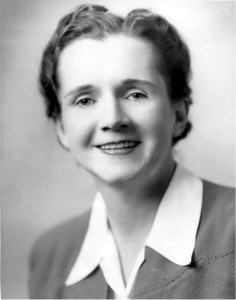This week, we return to coastal Maine, where environmental writer Rachel Carson spent her summers from 1952 until her death in 1964. In fact, so compelling was Carson’s study of the Maine coast that the Fish and Wildlife Service‘s wildlife refuge in Wells, Maine, was renamed the Rachel Carson National Wildlife Refuge in honor of the great naturalist.
Most people know Carson from Silent Spring, her 1962 indictment of pesticides, or from her studies of coastal environments – Under the Sea-Wind
, The Sea Around Us
, and The Edge of the Sea
.
Less well known, perhaps, is her wonderful book, The Sense of Wonder, which celebrates children’s awe as they experience the natural world around them. The Sense of Wonder is written for adults who want to nurture “the sense of wonder” in children – and who perhaps want to reinvigorate that sense of wonder in themselves.
The book began as “Help Your Child to Wonder” – a 1956 essay for Woman’s Home Companion magazine. After Carson’s death in 1964, the essay was published as a book and dedicated to her nephew, Roger, the child who inspired her reflections.
Near the middle of the book, Carson defines the “sense of wonder”:
A child’s world is fresh and new and beautiful, full of wonder and excitement. It is our misfortune that for most of us that clear-eyed vision, that true instinct for what is beautiful and awe-inspiring, is dimmed and even lost before we reach adulthood. If I had influence with the good fairy who is supposed to preside over the christening of all children I should ask that her gift to each child in the world be a sense of wonder, so indestructible that it would last throughout life. . . .
Carson believes that, while this sense of wonder is innate, a birthright for every child, adults can and should play a key role in nurturing this delight at the natural world. She describes her outings into the natural world with Roger – and it is clear that, even as a seasoned naturalist, she perhaps gains as much from these outings (perhaps even more so) than Roger does. Both are (re)connected with the profound experience of being alive.
“If a child is to keep alive is inborn sense of wonder,” writes Carson, “he needs the companionship of at least one adult who can share it, rediscovering with him the joy, excitement and mystery of the world we live in.” How to be such an adult is the lesson of this wonderful book.
So powerful is this book – and its invitation to share multigenerational wonder about the natural world – that the Environmental Protection Agency runs an annual “Rachel Carson Sense of Wonder” contest, in which a team of two or more persons – one a young person, the other an older person – submit a poem, essay, photo or dance video that expresses the sense of wonder the contestants share.
How have you nurtured a child’s sense of wonder? What stories can you tell about rediscovering the “joy, excitement and mystery of the world we live in”? Share your tales!
Join me this week on Pinterest as I pin images and resources related to Rachel Carson. Take a look around at all my boards – or go straight to “My Favorite Books” board for Rachel Carson treats.
And don’t forget to leave a comment on this post! If you subscribe to the weekly StoryWeb email and leave a comment here, you’ll be entered into a monthly drawing to win a StoryWeb T-shirt.
Note: This post originally appeared on the U.S. Fish and Wildlife Service’s “Connecting Children to Nature Through American Literature 1890 – Today” blog. I was delighted to be a guest blogger for this important project.
Podcast: Play in new window | Download
Subscribe to StoryWeb in iTunes.Subscribe to StoryWeb in Stitcher.
Image credit: U.S. Fish and Wildlife Service, public domain.
